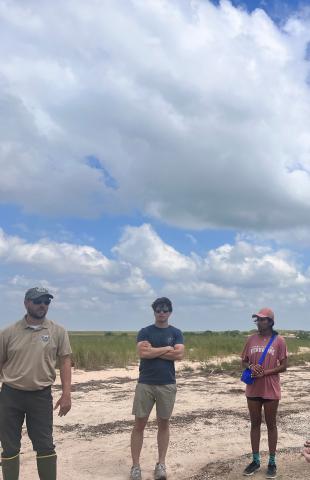Louisiana Sea Grant connects EESC PhD student with South Louisiana communities
Mon, 06/05/2023 - 11:48amLearning about Community-Engaged Scholarship
Naomi Mathew, an Earth and Energy Sciences PhD program candidate, has received a great honor to start her research-packed summer with being a part of the Graduate Research Scholar Program hosted by the Louisiana Sea Grant. The 5-day field trip in late May 2023 provided a unique experience of not only learning about Louisiana coastal research and restoration, but also understanding a deep societal impact of these projects. The 5-day retreat started in Baton Rouge, where the Louisiana Sea Grant is located, then the scholars took the exploratory trip through South Louisiana. The first location visited was the LSU Center for River Studies, where Naomi got to see the geological history of the Louisiana coast, the Mississippi River Model, and got a better understanding of what the Louisiana Coastal Protection and Restoration Authority (CPRA) does. From there, the team drove to the Bonnet Carré Spillway and discussed flood control and why river diversions can be important to Louisiana. The second day started off in the air! Naomi and her teammates boarded seaplanes, with Southern Seaplanes, and got an amazing aerial view from New Orleans to the marshes down river. It provided a well-rounded picture of all the maps and photos of the Mississippi delta we are constantly exposed to via Google Earth and study books. From the flight to Parish Marina, the team got both a water tour to see the Central Wetlands Reforestation as well as the Inner Harbor Navigation Canal Lake Borgne Surge Barrier, also known as the “Great Wall of Louisiana.” The 2013-built barrier is protecting vulnerable metro New Orleans areas from big storms. Next the scholars visited the Docville Farm, an organization that embraces leaning and brings back native flora to St. Bernard Parish. One of the organization’s key missions is to improve the quality of life in the area, through community support, education, and outreach. That was the start of bringing the human factor in. The third day really resonated with Naomi. The Louisiana Sea Grant helped early-career researchers connect characters, they learned about from documentaries and movies, to the actual people and community of the Point Au Chien Indian Tribe. It was a great honor to ride with Chief Donald Dardar in his boat down the channels that used to house his ancestors, grandparents, parents, and neighbors, some of which lived there not so long ago. He talked about the struggle his community has experienced with the receding lands, their shrimping strife, and how hard it has been for them to become federally recognized as a tribe. The devastation from the 2021 Hurricane Ida is still seen everywhere in their community. The Chief and his people opened their arms and truly made Naomi and her new friends feel welcome with the shrimp boil, with shrimp that his family caught. The story of a mom, who had to leave her family home because their only school closed, will live in Naomi’s heart for many years. She told about their community fight for not only bringing the school back but also for establishing their own school district in order to be able to teach their children tribal French. After that life changing experience, the scholars went down to the St. Mary Seafood, owned by Daniel Edgar, and began to understand challenges of the Commercial Fisheries in Louisiana. Edgar showed them how crafty and innovative Louisianians can be. The fourth day started with airboat rides, exploring the marsh terraces, understanding their ecological importance, and how they contributed in reconstructing habitats for whooping cranes. Another boat ride brought the team to the Water Control Structures and to a tour of a family run seafood processing plant, Gulf Crown Seafood Processing Plant. It was an incredible discovery of how intricate the process is. Another example of how resilient South Louisiana is came from seeing Bayou Carlin Cove, recent community effort to support recreational fishing, fish market, and morale. On the last day the scholars got to see Frugé Aquafarms and JT Meleck Distillers where they discovered how this family continued their rice farm legacy through innovating their crawfish aquafarms and distillery, fully supported by their rice farm. They wrapped up the trip with the chance to meet and talk to some stakeholders from the South Louisiana community. Naomi thinks this focused scholarship program provided a critically-needed experience and new perspective and meaning for being a researcher in Louisiana. The scholars were also trained throughout how to successfully tackle science communication, a very necessary tool so that we, as scientists, aren’t disconnecting ourselves from the community we study in and do our research for. The group of participating graduate students from diverse scientific backgrounds helped Naomi learn as well, where the future of Louisiana research and outreach is going.

Rockefeller beach at the Rockefeller Wildlife Refuge photo (left to right): Rockefeller Park Ranger, Jackson de Gruy (UL Lafayette alumnus, now LSU law student)), and Naomi Matthew.
Southern seaplane photo (left to right): Lee Potter (PhD student at LSU), Tessa Rock (a Master’s student in the UL Lafayette Biology Department), and Naomi Matthew.
